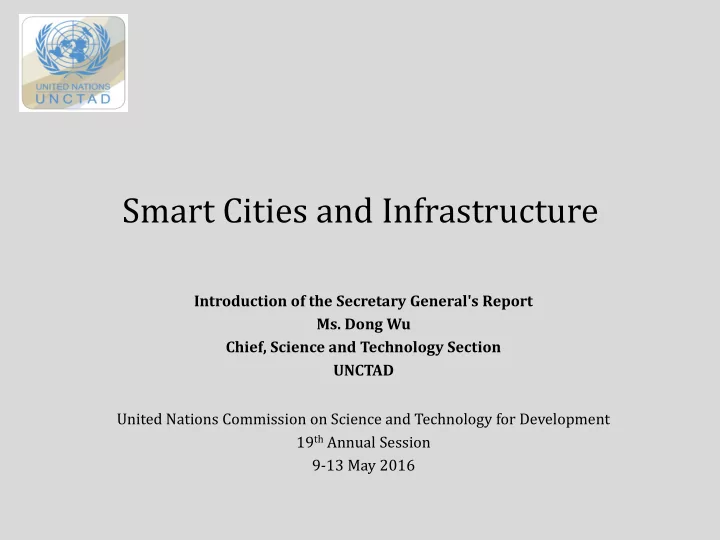

Smart Cities and Infrastructure Introduction of the Secretary General's Report Ms. Dong Wu Chief, Science and Technology Section UNCTAD United Nations Commission on Science and Technology for Development 19 th Annual Session 9-13 May 2016
Contents of the Report 1. Urbanization trends 2. Defining smart cities 3. Challenges related to smart cities and Smart Infrastructure 4. Design principles 5. Recommendations
Urbanization Trends Growth of urban areas during 2008: World Urban 2000-2030 , will 2050 : Two-thirds of population exceeded global population be larger than the the rural population will live in Cities cumulative expansion in human history 2030 : 60% of global population will live in Cities Anticipated global Cities account for 70% of global energy infrastructure investments in the next 40 years will use and greenhouse gas emissions but only be higher than the occupy 5% of the earth’s landmass. cumulative infrastructure spending of the past 4000 years
Source: http://linksviz.aqrashik.com/
Definition of Smart Cities “ A smart sustainable city is an innovative city that uses information and communication technologies (ICTs) and other means to improve quality of life, efficiency of urban operation and services, and competitiveness, while ensuring that it meets the needs of present and future generations with respect to economic, social, environmental as well as cultural aspects ” ITU study group on SSC
Smart Digital Infrastructure Helps monitor different Smart Buildings parameters of Improve comfort the city; analyze of users ; optimize the data usage of utilities, collected Smart Health Shift in focus to prevention; remote access to healthcare and personalized healthcare solutions Smart Mobility Smart Optimize traffic conditions; customized traffic Infrastructure solutions; reduce environmental footprint Smart Waste Management Smart Energy Improve efficiency of waste Optimize energy collection, pickup, separation, distribution and usage; reuse and recycle enable community- Smart Water based energy Reduce cost and monitoring leakage; increase reliability and transparency of water distribution
Challenge I : The Need for Localization of Smart Infrastructure Harness the local innovation system Case Studies: 'Smart Shack' South Africa Collaborations between two science parks and several other stakeholders for smart mobility project, Sweden Promote Open Science and Open Data Models Case Studies: Apps4SG competition, Singapore Civic Hacking events worldwide Establish urban innovation units, living labs and exploit regional innovation networks Case Studies: The new urban mechanics lab in Mayor’s office, Boston, USA European Innovation Partnership on Smart Cities and Communities
Challenge II : Skills Gap Accelerate STEM education programs Case Studies: The Urban data school, UK Science of Smart Cities Program, USA Reform Curriculums, Promote Multi-disciplinary Learning Case Studies: MOOC on 'Smart Cities', The Open University Partner with Technology Firms Case Studies: Cisco and IBM partnerships with city governments
Challenge III : Lack of Finance and well developed Business Models Develop Technology Driven Innovative Financing Models Case Studies: Provision of drinking water through the Jisomee Mita programme, Kenya KFW scheme to monetize the energy efficiency gains of buildings, Germany Monetize Data Caveat Ensure protection of privacy Generate finances through smarter use of existing public resources Examples: Better use of public resources, Efficient taxation, case study: Kampala, Uganda
Challenge IV: The Governance Challenge Choose governance models that fit Need to local contexts breakdown silos within government departments Balance top- down and bottom-up governance approaches
Challenge V : Making Smart Cities Inclusive Help to formalize the informal sectors through smart applications Case Study: Applying mobile technology to map the informal settlements and informal sectors, Brazil, Monrovia & Tanzania Provide affordable smart infrastructure for the informal sector Case Studies: M-KOPA: Combining mobile technology and solar power to make available and affordable energy solutions for informal settlements, East Africa Make Smart cities gender sensitive
Smart Infrastructure Design Principles People-Centered and Inclusive Infrastructure Resilience and Sustainability Interoperability and Flexibility Managing Risks and Ensuring Safety
• Adopt a participatory and integrated approach to smart city development • Integrate the smart city agendas within national STI and ICT policies • Strengthen the core ICT infrastructure Governments • Conduct skill gap analysis within workforce • Promote open data and open science models • Incorporate insights obtained from data generated from smart city into the governance process Recommendations • Develop interoperability standards and other standardization measures International • Promote regional collaborations for pilot Community projects and for benchmarking • Highlight the critical role of STI community in facilitating smart cities • Share and analyze evidence on successful examples of CSTD localization of smart infrastructure • Provide a forum to share evidence on successful models that incentivize local innovation
Recommend
More recommend